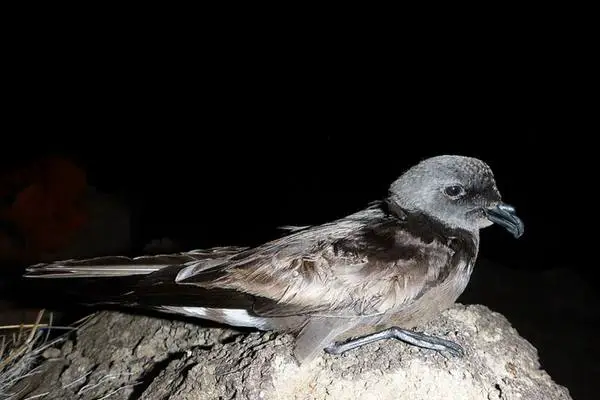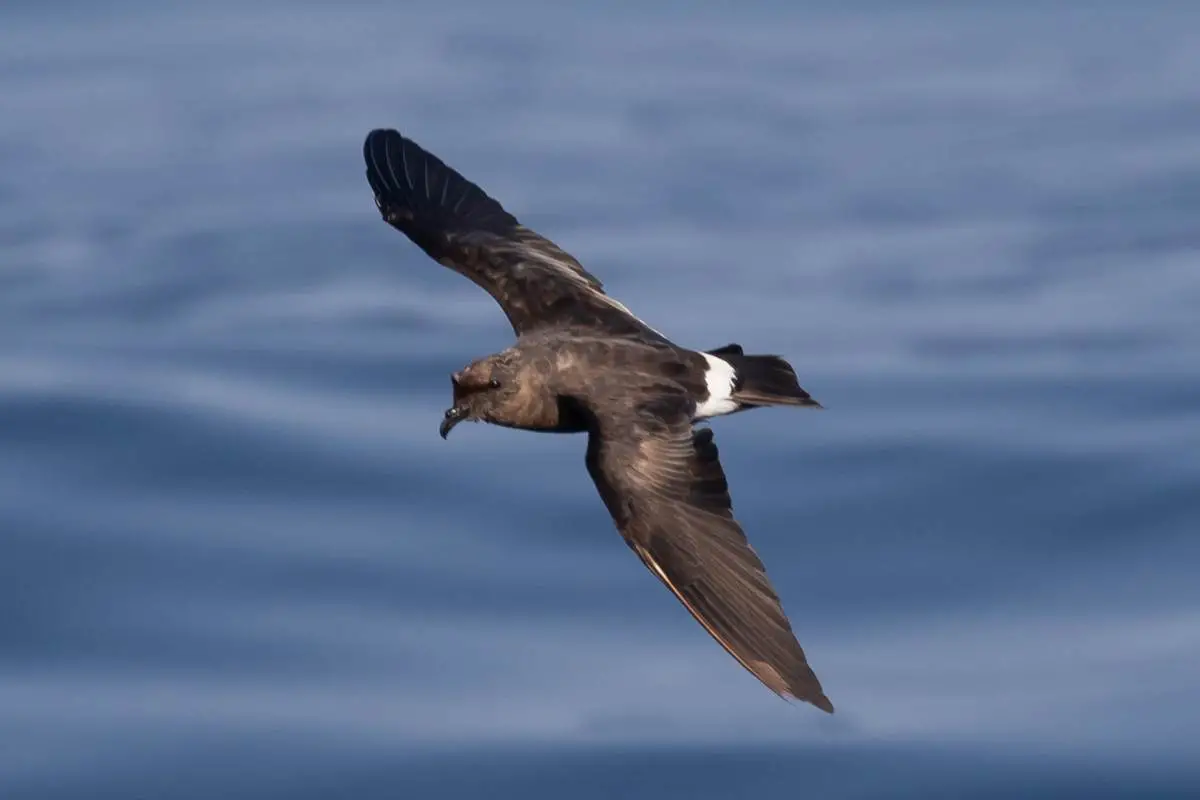Band-rumped storm petrel gliding | image by Ryan Mandelbaum via Flickr | CC BY 2.0
Common Name: Band-rumped Storm Petrel
Scientific Name: Hydrobates castro| Size | Diet | Range in Hawaii | Status in Hawaii |
|---|---|---|---|
| 7 in. | fish, krill, squid, and small crustaceans | Big Islands | Endangered |
The band-rumped storm petrel (Oceanodroma castro) is a small seabird species that belongs to the family Hydrobatidae. It is found in the Atlantic Ocean and the Caribbean Sea, where it breeds on islands and coastal cliffs. This species is also known as the white-rumped storm petrel or the Madeiran storm petrel.
Band-rumped Storm Petrel
Appearance

The Band-rumped Storm Petrel is a small bird, with a length of about 7 inches (18 cm) and a wingspan of about 16 inches (41 cm). It weighs around 1.1 ounces (32 grams). The Band-rumped Storm Petrel has a dark brown or blackish upper body, with a pale band across the rump and a white underbody. It has a distinctive, hunchbacked appearance when perched, with long wings and a short, square tail.
Diet
Band-rumped storm petrels are opportunistic feeders and will eat a variety of small prey, including fish, krill, squid, and small crustaceans. They forage over the ocean’s surface, often following schools of fish or other prey.
Storm petrels have a unique feeding technique called “pattering,” in which they patter their webbed feet on the surface of the water to stir up small prey items. They then use their long, thin bills to scoop up the prey. Overall, the diet of band-rumped storm petrels is highly variable and depends on the availability of prey in their local environment.
Behavior
Band-rumped storm petrels are highly social and often form large colonies on their breeding islands. They are nocturnal during the breeding season, coming ashore at night to mate and tend to their nests.
During the day, these birds are pelagic, spending most of their time at sea. They are highly agile fliers and are known for their acrobatic displays, which often involve soaring and gliding on updrafts.
Band-rumped storm petrels are also known for their distinctive calls, which are often used to communicate with other members of their colony. These calls are typically high-pitched and nasal, and are used to attract a mate or to defend a territory.
Nesting
During the breeding season, band-rumped storm petrels build nests on the ground in burrows, crevices, or small cavities. These nests are typically located in rocky or sandy areas, often on cliffs or in underground burrows.
The male and female both participate in nest construction, which typically involves lining the nest with grass, feathers, or other soft materials. The female typically lays a single egg, which is incubated by both the male and female for about 45 days.
Once the chick hatches, it is fed by both parents, who bring food back to the nest and regurgitate it for the chick. The chick fledges at around 70 days, at which point it becomes independent and begins to forage on its own.
Band-rumped storm petrels typically only breed once per year, but may occasionally produce two broods in a season if conditions are favorable. They are known for their strong mate and territory fidelity, with many pairs remaining together for multiple breeding seasons.
Habitat
Band-rumped storm petrels are pelagic and can be found over the open ocean, often following schools of fish or other prey. They are generally found in marine environments, including near the coast, in bays and estuaries, and in offshore waters.
Range
It is not clear whether band-rumped storm petrels breed in Hawaii, as there are no known breeding colonies in the state. However, it is possible that individuals may occasionally visit Hawaii during their migration, as they are known to travel long distances between their breeding and non-breeding grounds.
Conservation Status
This species is classified as “Endangered” by the U.S. Fish & Wildlife Service (USFWS) due to habitat loss and predation by introduced mammals on their breeding islands. However, recent conservation efforts have helped to stabilize and increase their population.
Interesting facts
1. They are pelagic species
The Band-rumped Storm Petrel is a pelagic species, which means that it is found over the open ocean rather than close to land. It feeds on a variety of small marine organisms including plankton, squid, and small fish.
2. They are a colonial nester
The Band-rumped Storm Petrel is a colonial nester, and it breeds in large colonies on cliffs, cliffs, and other rocky outcrops. The female lays a single egg, which is incubated by both parents for about 42 days. The chick hatches altricial, meaning that it is naked and helpless, and it is fed by both parents until it fledges at about 42-56 days old.
3. They are a non-migratory species
The Band-rumped Storm Petrel is a non-migratory species, and it breeds on a number of islands in the eastern Pacific Ocean and the Caribbean Sea. It is thought to have a relatively large population, and it is not considered to be at risk of extinction.
4. A host of the parasitic pigeon louse
The Band-rumped Storm Petrel is a host of the parasitic pigeon louse, which is a small insect that feeds on the feathers and skin of doves and pigeons. The pigeon louse is not harmful to humans, but it can cause irritation and stress to the host bird.
Frequently asked Questions:
What are the main threats to the Band-rumped Storm Petrel in Hawaii?
The main threats to the Band-rumped Storm Petrel in Hawaii include habitat loss, habitat degradation, pollution, and the introduction of non-native species. These factors can have a negative impact on the population of the species and its ability to breed and survive.
How does the Band-rumped Storm Petrel communicate?
The Band-rumped Storm Petrel is known for its distinctive call, which sounds like a series of soft, hiccupping clicks.
What is the lifespan of the Band-rumped Storm Petrel?
The lifespan of the Band-rumped Storm Petrel is not well documented, but it is thought to be similar to that of other small seabirds, which is around 5 to 10 years.




